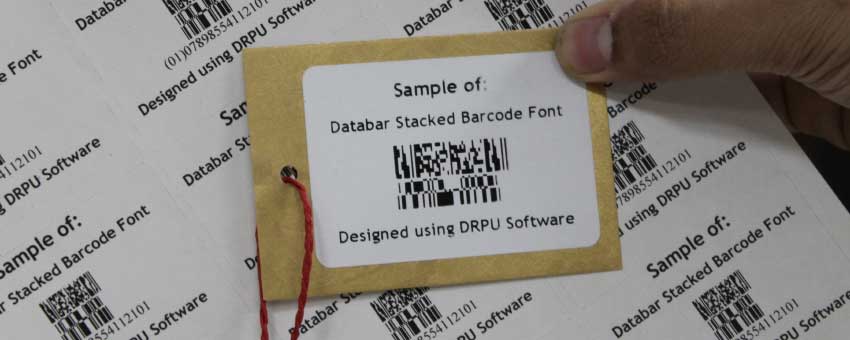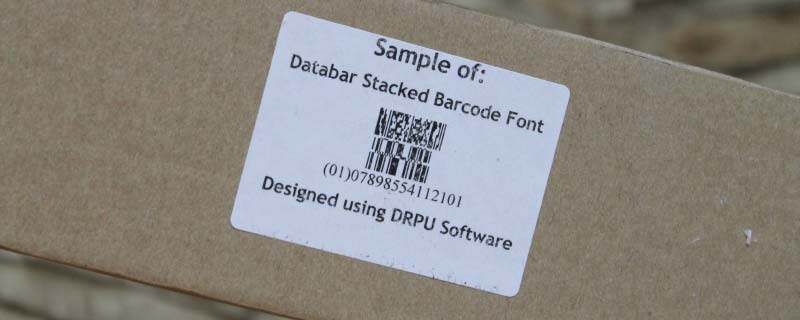The Advantages of using a Databar Stacked barcode
GS1 DataBar Stacked barcode, also known as the stacked omnidirectional barcode, is a 2D barcode format designed for encoding small amounts of data in limited space. Compared to traditional linear barcodes, DataBar Stacked barcode offers several advantages in terms of data capacity, scanning capabilities, and application flexibility. In this article, we will discuss the advantages of using DataBar Stacked barcode in various industries.
-
Increased Data Capacity
One of the primary advantages of using DataBar Stacked barcode is its increased data capacity. The barcode can encode up to 74 characters, which is significantly higher than traditional linear barcodes. This increased data capacity allows retailers to encode more product information, including batch/lot number, expiration date, weight, and price. This information helps retailers to manage their inventory efficiently, track products, and reduce waste.
-
Enhanced Scanning Capabilities
DataBar Stacked barcode offers enhanced scanning capabilities compared to traditional linear barcodes. The barcode can be scanned from any direction, making it more flexible and easier to use. It also offers higher scanning accuracy, even when the barcode is damaged or partially obscured. This feature ensures that the barcode can be scanned correctly, even in harsh environments.
-
Increased Efficiency
DataBar Stacked barcode can improve the efficiency of various business processes. For example, in the retail industry, it can be used to speed up checkout times by scanning multiple items at once. This reduces waiting times for customers and improves overall customer satisfaction. In the healthcare industry, it can be used to quickly access patient information, thus improving the quality of patient care.
-
Reduced Costs
DataBar Stacked barcode can help reduce costs for businesses. For example, it can be used to track inventory levels, allowing businesses to reduce waste and avoid overstocking. It can also be used to automate certain processes, such as ordering new inventory when stock levels reach a certain threshold. This helps businesses to reduce labor costs and improve overall efficiency.
-
Compliance with Industry Standards
DataBar Stacked barcode is compliant with industry standards set by GS1. This ensures that the barcode can be read by any barcode scanner, regardless of the manufacturer or model. It also ensures that the barcode is compatible with other industry systems, such as supply chain management systems and inventory management systems.
-
Improved Product Tracking
DataBar Stacked barcode helps improve product tracking throughout the supply chain. The barcode can be used to track the movement of goods from the manufacturer to the retailer, ensuring that products reach their intended destination on time. This improves supply chain efficiency and reduces the risk of product loss or theft.
The Limitations of using a Databar Stacked Barcode
While GS1 DataBar Stacked barcode offers several advantages over traditional linear barcodes, it also has some limitations that businesses should be aware of. In this article, we will discuss the limitations of using DataBar Stacked barcode and how they can impact businesses.

-
Limited Data Capacity:
While DataBar Stacked barcode offers increased data capacity compared to traditional linear barcodes, it still has a limited capacity. The barcode can only encode up to 74 characters, which may not be sufficient for some applications. Businesses that need to encode a lot of product information may find the data capacity limiting.
-
Limited Compatibility:
DataBar Stacked barcode is not compatible with all barcode scanners. Some older scanners may not be able to read the barcode, which can cause issues for businesses that use these scanners. Additionally, the barcode may not be compatible with some software applications, which can limit its usefulness.
-
Printing Issues:
DataBar Stacked barcode requires high-quality printing to ensure that it can be read accurately. If the barcode is printed poorly, it may not be readable by scanners, which can cause issues for businesses. Additionally, printing errors can cause the barcode to be misread, leading to inaccurate data.
-
Cost:
DataBar Stacked barcode requires specialized equipment, barcode software, and proper training, which can add to its overall implementation cost. Businesses that need to adopt the barcode may need to invest in new hardware, software, and training, which can be a significant expense.
-
Limited Industry Adoption
DataBar Stacked barcode is not as widely adopted as other barcode formats, such as QR codes and Data Matrix codes. This can limit its usefulness for businesses that need to interact with other businesses or customers that use these other formats. Additionally, it can limit the availability of hardware and software that support DataBar Stacked barcode.
-
Limited Application Flexibility
DataBar Stacked barcode is primarily designed for use in retail and healthcare applications. While it can be used in other industries, its limited data capacity and compatibility can make it challenging to use in some applications. Businesses that need to encode a lot of data or that operate in industries with specialized requirements may find the barcode limiting.
In Conclusion, the limitations of using DataBar Stacked barcode are primarily related to its limited data capacity, compatibility issues, printing issues, limited industry adoption, limited application flexibility, and cost. While the barcode offers several advantages over traditional linear barcodes, businesses need to carefully consider these limitations and determine whether they are significant enough to impact their operations. In some cases, businesses may need to consider using alternative barcode formats, such as QR codes or Data Matrix codes, to meet their needs.
Download and Install DataBar Stacked Barcode Software
The Cost of Implementing a Databar Stacked Barcode
The cost of implementing a Databar Stacked barcode depends on several factors, including the size and complexity of the organization, the number of products to be labeled, the type of barcode hardware and software required, and the level of expertise required to implement the system.
Here are some of the factors that may affect the cost of implementing a Databar Stacked barcode:
-
Barcode scanner and printer hardware:
The cost of barcode scanner and printer hardware will depend on the number of devices required, their features, and their quality. A basic barcode scanner can cost around $50, while a high-end scanner with advanced features can cost over $500. Similarly, a basic barcode printer can cost around $150, while a high-end printer can cost over $1,000.
-
Barcode software:
The cost of barcode software will depend on the type of software required and the number of licenses needed. Some software applications may require an upfront license fee, while others may be available as a subscription service. The cost of barcode software can range from a few hundred dollars to several thousand dollars.
-
Barcode labels:
The cost of barcode labels will depend on the type of label required, the quantity ordered, and the supplier chosen. Basic barcode labels can cost as little as a few cents per label, while high-quality labels can cost several dollars per label.
-
Implementation and training:
The cost of implementation and training will depend on the level of expertise required to set up the system and train staff. For smaller organizations, it may be possible to implement the system in-house, while larger organizations may require the assistance of a third-party consultant. The cost of implementation and training can range from a few hundred dollars to several thousand dollars.
-
Maintenance and support:
The cost of maintenance and support will depend on the level of support required and the type of maintenance plan chosen. Some suppliers may offer basic support as part of the initial purchase, while others may charge an ongoing support fee. The cost of maintenance and support can range from a few hundred dollars to several thousand dollars per year.
Overall, the cost of implementing a Databar Stacked barcode will vary depending on the organization's specific needs and requirements. However, by carefully considering the factors outlined above, organizations can develop a budget that accurately reflects the cost of implementing and maintaining a barcode system.
Posted By: 👤 Techsavvy
|Updated On: 📅
